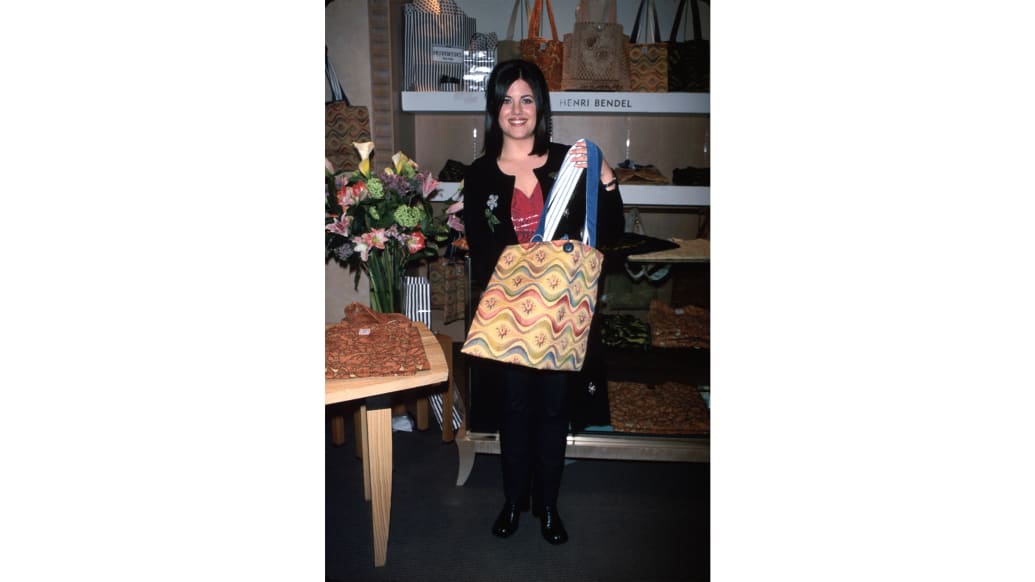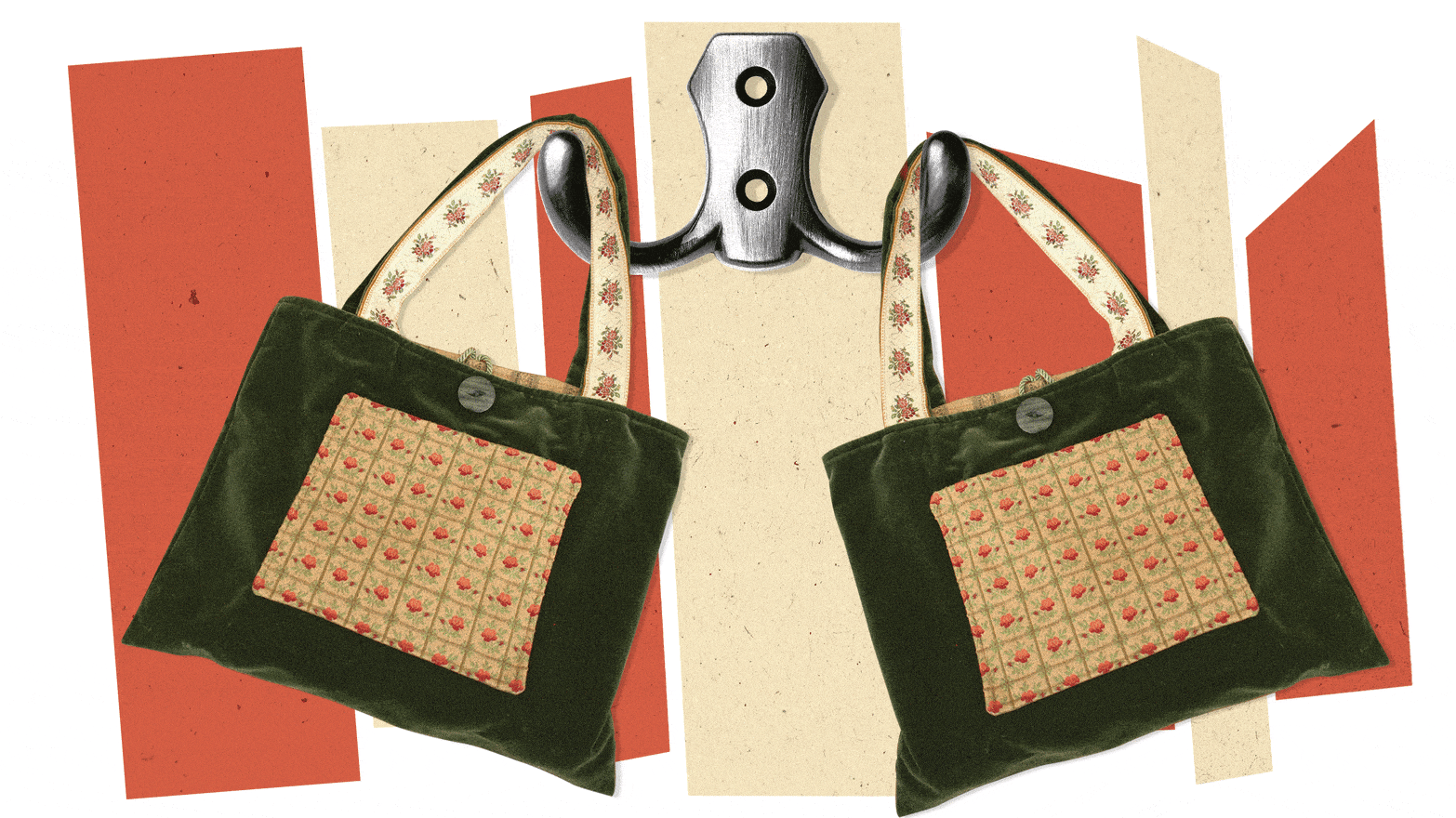“This looks like a purse made for substitute teachers.”
“It brings me right back to Y2K.”
“This is like, the easiest pattern to sew.”
“It’s just two washcloths sewn together.”
So goes the criticism I received on my most recent eBay purchase, a handbag from Monica Lewinsky’s short-lived 1999 collection. The homespun design features a Laura Ashley-esque floral pattern sewn over a parakeet green, faux-velvet base. No matter what anyone says, I love it.
Even as the most questionable elements of noughties fashion sneak back into style (see: low-rise jeans, visible thongs, and chunky Steve Madden flip flops), The Real Monica Inc. remains a neglected footnote from the era.
Lewinsky’s tote bags are relegated to the laundry list of her first awkward post-Clinton ventures, like working as a Jenny Craig spokesperson and hosting a questionable Fox dating show where male contestants competed for love—in wrestler masks.
Kooky hustles aside, Lewinsky needed the money. In a 2000 New York Times feature, the former White House intern admitted that she started the collection to help get out of debt. Working through legal fees to the tune of $1.5 million, with a name the press mercilessly maligned for months, the amateur knitter had little to lose.
Though every bag came with a tag that reads, “Made just for you by Monica,” that's not entirely true. According to the Times, Monica designed the handbags, but each one was handmade in a Louisiana plant.
The totes were stocked by New York's Henri Bendel, L.A.’s Fred Segal, and the World Wide Web’s TheRealMonicaInc.com.
That URL went dark in 2004. Bendel’s closed last winter. In an email, representatives for Fred Segal wrote, “Unfortunately we don’t have an information on [the bags].”
Through her representatives, Lewinsky (very kindly) declined to comment.

Sylvain Gaboury/DMI/The LIFE Picture Collection via Getty
When I began my search for a Real Monica bag, I found only three options readily for sale. Two came courtesy of eBay, and one lives on the consignment site Tradesy.
Back in the day, these cost between $80 and $170. When I checked on Tradesy, one brown, baroque-printed hobo with fringe at the bottom was on sale for a very specific price of $32.57. The two eBay options cost $154 and $269, respectively.
I hit up a few experts and consignment shopkeepers to help with my search. Many who responded were unaware that Lewinsky ever had a handbag line. A few sent over the eBay links I had already found.
“These are collector’s pieces for sure,” Julie Ann Orsini, a fashion archivist, told me over the phone, before backtracking. “It’s not a fashion collector’s piece, let me make that distinction. You’re not going to find these in any real, high-end, vintage stores.”
Richard Ives, who owns PilgrimVintage in New York, delivered this particularly blunt reply via email: “We deal in luxury and designer vintage handbags. Her bags were neither. Probably more likely to be in GoodWill or [The] Salvation Army.”
Abby Ellin wrote the aforementioned New York Times business story on Lewinsky. (Ellin has also contributed to The Daily Beast.) She also owns a Made by Monica tote of her own, which she keeps safely locked away in a Midtown storage facility.
Lewinsky gifted the columnist the leopard-printed number as a token of her appreciation for writing a respectful, nuanced profile. Articles like Ellin's were, of course, few and far between during a time when The New York Post infamously dubbed Lewinsky the “portly pepperpot.”
Over in the politics section of the Times, Ellin’s celebrated colleague Maureen Dowd won a Pulitzer for her obsessive coverage of Lewinsky. Dowd published all the slut-shaming fit to print. She also never passed up an opportunity to make a fat joke at the then 24-year-old’s expense.
According to Ellin, Lewinsky especially loved the fact that the Times legitimized the handbag company by calling her an “entrepreneur” in its headline. Marcia Lewis, Lewinsky’s mother, makes an appearance in the story, and she later called Ellin to thank her for the article.
Though most press at the time threw around the word “boho” when describing Lewinsky's designs, my 2019 interpretation is that these are decidedly not throwback pieces. They reek of the folksy ’90s. The purse’s hippie-meets-grunge aesthetic evokes Reality Bites-era Winona Ryder, another infamous name in the retail world.
“It looks like two shmatas put together, with fringe and beads on it,” Ellin says of her tote. “They were fun. That’s the word—they were fun.”
Today, Kate Coyne is the executive editor of People magazine. In 1999, she served as a Page Six columnist, where writers gleefully maligned Lewinsky at every opportunity.
“We were not the kindest to Monica in a lot of ways that seem particularly cringeworthy and horrible when you look back now,” Coyne recalled.
“While I can take some comfort knowing I personally never wrote any items about her or her appearance, I read those articles, saw them, and—this is horrible to say—probably laughed at some of the funnier terms and phrases,” she added.
One night while working late, Coyne visited TheRealMonicaInc.com out of curiosity. To her slight surprise, she found the handbags “really cute.” She bought four—one as a Christmas gift to her grandmother, another to give as a gag to a girlfriend about to take a job in D.C., and two to keep for herself.
Those days, the reporter still got most of her tips through a fax machine, so the idea of online shopping seemed novel. “I don’t know if I can officially say this, but it may be the first thing I bought online,” Coyne said.
Before she left the website, Coyne visited Lewinsky’s customer service page. There, she found a portal where shoppers could type in special requests, send questions, or complaints.
“I typed a little note to her, what was essentially an apology on behalf of the New York Post,” Coyne said. “It did force me to reckon with the reality of what I did for a living. Being a girl the same age that she was, I definitely felt for her.”
Lewinsky never replied. But Coyne still happily uses her Made by Monica bags for storage. One holds bathing suits and the other is reserved for paint supplies. Her mother had a “ripoff Missoni rainbow print” version that Coyne has since stolen and keeps as her own.
“They’re good bags,” Coyne asserted. “They’ve officially reached the status where if I ever lost one, I would be very, very mad.”
Coyne has used the hefty totes to carry clothes and toiletries for weekend trips. “They’re pretty indestructible,” the editor assessed. “They have stood the test of time; they haven’t broken. Well, a button closure fell off of one, but my dog gnawed it off. That’s not Monica’s fault.”
Ultimately, I bought the $154 Made by Monica tote from an eBay seller who lives in Levittown, Pennsylvania. That faceless avatar is a speedy shipper, but they unfortunately did not return my request for comment—so I know nothing about my new bag’s origin.
Maybe it lived on a Bendel shelf before the previous owner picked it up. Perhaps my seller bought it online, suspect of that new form of shipping, not knowing if it would ever arrive at her front door. Either way, it’s mine now.
Sometimes women buy purses to signal a new era. You might splurge on a Chloe satchel when you get a new job. Your mom could buy you a Kate Spade work tote as a graduation gift. If you are Stormi Webster, daughter of Kylie Jenner, you get a mini Hermès because you are a very big girl who just turned 1.
I recently turned 24, the same age as Lewinsky was when the Clinton affair broke. Unless something goes very, very wrong, I doubt my year will be half as explosive as 1998 was for her.
But just like my handbag designer, I’ve run errands for creepy bosses. I’ve poured my heart out to people I mistakenly thought I could trust; none of them were wearing a wire, but betrayals still sting. No matter how much I smile or how charming I am, to some men I will never be more than “that woman.”
And, despite all that, just like Monica and so many other women in the world, each morning I wake up, get dressed, sling a packed purse over my shoulder, and head out the door.

